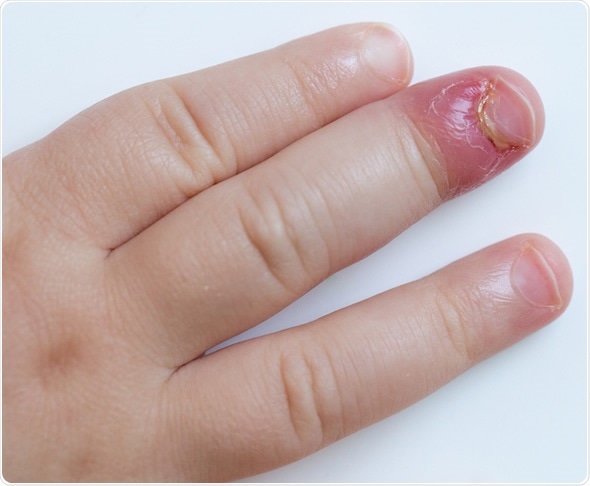What is Paronychia?
Paronychia is a skin infection which occurs around the nail. It affects the nail fold tissue and may cause changes in nail shape, color or texture. The infection can be caused by a bacteria, fungi, or yeast.
There is also the possibility of both bacterial and fungal infection at the same time. It is fairly common and can cause the affected area to become swollen, red and painful. The infection may result in fluid-filled blisters over a period of time. Although the presence of blisters is not always registered. The condition is also called whitlow.

Paronychia, swollen finger with fingernail bed inflammation due to bacterial infection on a toddlers hand. - Image Copyright: zlikovec / Shutterstock
Types of Paronychia
There are primarily two types of paronychia which may develop around the finger or toenails. These are classified by the time duration that the skin infection lasts.
Acute Paronychia: The skin infection develops fast and lasts for a few days in acute paronychia. This kind of paronychia is seen following skin breaks during a manicure, or when infection sets into an ingrown toenail. It is usually bacterial in nature, often caused by straphylococcus aureus bacteria. However, germs from the cold sore virus like herpes simplex or yeast such as Candida may also cause the condition.
Chronic Paronychia: The infection develops slowly and may last for many weeks. In such cases, a mix of multiple pathogens causes the infection. A combination of yeast like candida, virus like herpes simplex, and bacteria like Staphylococcus aureus may be found. This condition is commonly found in people who have to work with their hands constantly being exposed to water, chemicals and detergents. It has a tendency to reoccur even after being treated and cured.
What Causes Paronychia?
Skin infections set in when there is an injury already present in the nail fold area. A break in the skin between the cuticle and the nail plate is an ideal place for pathogens to gather and infection to begin. People who have a habit of picking at the skin around the nail, or babies who suck thumbs and break the tender skin around the nail are quite likely to develop chronic paronychia.
People who have diabetes are more prone to skin infections in general and tend to get paronychia frequently. It takes them longer to heal from the infection than non-diabetics. Also, those who suffer from medical conditions that cause poor blood circulation are likely to get paronychia.
Certain occupations such as fishermen, dairy farmers, bartenders, and cleaners are predisposed to get paronychia. This is because their work exposes them to both a source of pathogens as well as a possibility of cuts on the skin. Women, especially homemakers, are affected more often than men. It is not hereditary.
Diagnosis and Prognosis of Paronychia
No special test is required to diagnose paronychia. A health care provider can usually identify the condition by a simple visual examination. If there is pus or fluid in the blister, it may be analyzed in the lab to check for the type of bacteria or fungus causing the infection. The outlook after diagnosis is fairly good for the disorder.
While fungal infections may take much longer to clear up, as treatment begins the pain is brought under control almost immediately. The tenderness of the skin also recedes. Acute paronychia will disappear within a matter of days. However since chronic paronychia takes longer to set in, it will take longer to heal. Even after chronic paronychia is cured, it may reoccur.
Treatment of Paronychia
The skin infection is treated with a combination of oral medication and local ointments. For acute paronychia caused by bacteria, oral antibiotics will be prescribed. If a blister is present, minor surgical intervention may be required. A local anesthetic is used to numb the area, and the health care professional will then lift the nail fold and cleanse the infected area.
The blister will be drained, and then a topical cream will be applied to fight the infection. It may be antibacterial or antifungal, based on the type of infection identified. In some cases, part of the nail may have to be removed if the blister is very deep rooted.
If there is no blister, the individual will be advised to soak their hands in warm water thrice a day, dry them properly, and apply the medicated ointment locally. Also, a skin-drying substance such as a skin paint, may be provided for professionals who are unable to avoid work conditions that cause paronychia.
Avoiding Paronychia
- Don’t bite or pull at the edge of a nail.
- Don’t suck on the thumb as it will make the skin tender and prone to breaks.
- Don’t push the cuticles back during a manicure.
- Ensure that all manicure tools are disinfected before using them on your nails.
- Wear gloves when washing dishes or handling chemicals.
- Keep your hands and feet clean and dry.
- Cut your nails after bathing when they are softer.
References
Further Reading